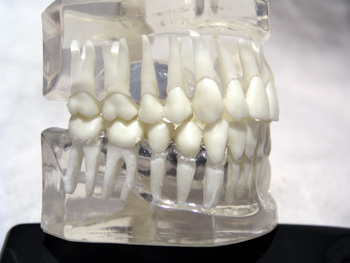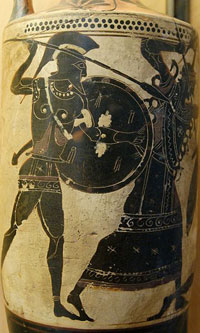Greek Combining Forms and Latin Roots

Source: Dental model of teeth, Håkan Svensson,
Wikimedia Commons
The main part of a word, without affixes, is called the root. Some roots retain their meanings just like affixes do and can be helpful to know. Many of these roots come from Latin, a much older language than English. Anni-, which appears in the word anniversary, is a Latin root that means “years.” Grad- means “step,” as in the word graduation—a step you will soon take. Dent-, as in the word dentist, means “tooth.” This makes it easy to see why one manufacturer named its denture adhesive Fixodent®.
By looking at roots, you’ll learn that some words have an interesting history. Indent is just such a word. We use indent with reference to writing. To “indent” is to add space between the text and the margin of a document, like you do at the beginning of a paragraph. So what’s that have to do with teeth? The etymology of indent—the origin of the word—reveals the answer. In the fourteenth century, two parties would draw up contracts on the same piece of paper. The contracts were cut apart with a matching line of notches that they called “teeth,” which could later be rejoined to prove authenticity. The workers who took part in such jagged-edged contracts became known as indentured apprentices.
There are also a number of Greek combining forms such as -cycle that have consistent meanings from word to word. You know that tricycle, bicycle, and motorcycle all have wheels in common. The word recycle involves the circular process of making new items from old ones. Another Greek combining form is -graph, which means “written.” Your written signature is your autograph, and a section of prose is called a paragraph. Someone who writes down the life story of another is known as that person’s biographer.

Source: Athena Gigantomachy MAR Palermo NI2026, Marie-Lan Nguyen, Wikimedia

Source: Demeter Altemps Inv8596 n2, Marie-Lan Nguyen, Wikimedia
It’s not important that you know whether each word part is a Latin or Greek form. What’s more important than the language of origin is the pattern in which they combine. If you know some common affixes and roots, you can quickly teach yourself the meanings of a score of new words. If you are alert to the prevalence of these meaningful word parts, you can look for them when you encounter challenging, multisyllabic words in your reading. How about that word multisyllabic? If you know that multi- is a prefix meaning “many,” you can deduce that the word means “many syllables.” This long word isn’t so daunting after all.